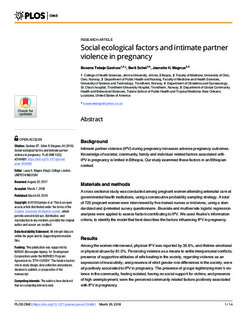| dc.contributor.author | Gashaw, Bosena Tebeje | |
| dc.contributor.author | Schei, Berit | |
| dc.contributor.author | Magnus, Jeanette H. | |
| dc.date.accessioned | 2019-03-20T08:30:01Z | |
| dc.date.available | 2019-03-20T08:30:01Z | |
| dc.date.created | 2018-06-29T20:39:39Z | |
| dc.date.issued | 2018 | |
| dc.identifier.citation | PLoS ONE. 2018, 13 (3), 1-14. | nb_NO |
| dc.identifier.issn | 1932-6203 | |
| dc.identifier.uri | http://hdl.handle.net/11250/2590748 | |
| dc.description.abstract | Background
Intimate partner violence (IPV) during pregnancy increases adverse pregnancy outcomes. Knowledge of societal, community, family and individual related factors associated with IPV in pregnancy is limited in Ethiopia. Our study examined these factors in an Ethiopian context.
Materials and methods
A cross sectional study was conducted among pregnant women attending antenatal care at governmental health institutions, using a consecutive probability sampling strategy. A total of 720 pregnant women were interviewed by five trained nurses or midwives, using a standardized and /pretested survey questionnaire. Bivariate and multivariate logistic regression analyses were applied to assess factors contributing to IPV. We used Akaike’s information criteria, to identify the model that best describes the factors influencing IPV in pregnancy.
Results
Among the women interviewed, physical IPV was reported by 35.6%, and lifetime emotional or physical abuse by 81.0%. Perceiving violence as a means to settle interpersonal conflicts, presence of supportive attitudes of wife beating in the society, regarding violence as an expression of masculinity, and presence of strict gender role differences in the society, were all positively associated to IPV in pregnancy. The presence of groups legitimizing men’s violence in the community, feeling isolated, having no social support for victims, and presence of high unemployment, were the perceived community related factors positively associated with IPV in pregnancy.
Conclusion
IPV in pregnancy is very prevalent in Ethiopia and is associated with multiple social ecologic factors. Reduction of IPV in pregnancy calls for cross sectorial efforts from stakeholders at different levels. | nb_NO |
| dc.language.iso | eng | nb_NO |
| dc.publisher | Public Library of Science | nb_NO |
| dc.rights | Navngivelse 4.0 Internasjonal | * |
| dc.rights.uri | http://creativecommons.org/licenses/by/4.0/deed.no | * |
| dc.title | Social ecological factors and intimate partner violence in pregnancy | nb_NO |
| dc.type | Journal article | nb_NO |
| dc.type | Peer reviewed | nb_NO |
| dc.description.version | publishedVersion | nb_NO |
| dc.source.pagenumber | 1-14 | nb_NO |
| dc.source.volume | 13 | nb_NO |
| dc.source.journal | PLoS ONE | nb_NO |
| dc.source.issue | 3 | nb_NO |
| dc.identifier.doi | 10.1371/journal.pone.0194681 | |
| dc.identifier.cristin | 1594916 | |
| dc.description.localcode | © 2018 Gashaw et al. This is an open access article distributed under the terms of the Creative Commons Attribution License, which permits unrestricted use, distribution, and reproduction in any medium, provided the original author and source are credited. | nb_NO |
| cristin.unitcode | 194,65,20,0 | |
| cristin.unitname | Institutt for samfunnsmedisin og sykepleie | |
| cristin.ispublished | true | |
| cristin.fulltext | original | |
| cristin.qualitycode | 1 | |

